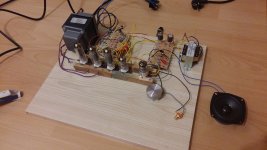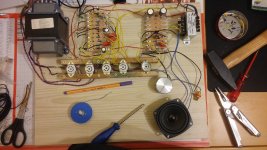Hey guys,
today i finished my first homemade tube amp (there's a first time for everything ) based on the Mullard 5-10 schematic from the r-type site. At first it hummed uncontrollably horrible (at I guess max volume) till i removed the feedback cable (from OT sec to C6/R11). Now it sounds not exactly the way HiFi is defined - but much better and the signal is hearable. What's the problem with feedback? It is supposed to be there but makes everything worse?
) based on the Mullard 5-10 schematic from the r-type site. At first it hummed uncontrollably horrible (at I guess max volume) till i removed the feedback cable (from OT sec to C6/R11). Now it sounds not exactly the way HiFi is defined - but much better and the signal is hearable. What's the problem with feedback? It is supposed to be there but makes everything worse?
The second questions is about humming in general. I have a little hum that disappears as soon as i plug the power cord (while signal fades out). Am I right it is caused by my (currently "experimental") grounding and heater wiring system?
Next, I built my amp without tone controls but with a volume pot (1M) and connected the middle to V1-pin9; the left to ground and the right to the signal. However, when i move the pot about millidegrees the volume literally explodes ^^. If I move it further it's only buzzing and doesn't get any louder. Any ideas on that issue?
Another thing - maybe the reason for the other problems - my voltages are much higher than the ones written in the Mullard paper. They are somewhat 40V higher (e.g. 360V at C15) - I read somewhere it's due to higher resistant DVM's today. Does anyone have voltages I can use to compare with mine? (Glad that i used higher rated caps than the Mullard ones )
)
Aaannd last question about the OT. I have an universal one where I can get a primary impendance of 6.8k or 5.6k. Mullard uses 6k (for my chosen version - low loading) - better to go higher or lower?
Thank you in advance and sry for so many questions and bad English
mhmhmh
ps: the wood is only for prototyping
today i finished my first homemade tube amp (there's a first time for everything
The second questions is about humming in general. I have a little hum that disappears as soon as i plug the power cord (while signal fades out). Am I right it is caused by my (currently "experimental") grounding and heater wiring system?
Next, I built my amp without tone controls but with a volume pot (1M) and connected the middle to V1-pin9; the left to ground and the right to the signal. However, when i move the pot about millidegrees the volume literally explodes ^^. If I move it further it's only buzzing and doesn't get any louder. Any ideas on that issue?
Another thing - maybe the reason for the other problems - my voltages are much higher than the ones written in the Mullard paper. They are somewhat 40V higher (e.g. 360V at C15) - I read somewhere it's due to higher resistant DVM's today. Does anyone have voltages I can use to compare with mine? (Glad that i used higher rated caps than the Mullard ones
Aaannd last question about the OT. I have an universal one where I can get a primary impendance of 6.8k or 5.6k. Mullard uses 6k (for my chosen version - low loading) - better to go higher or lower?
Thank you in advance and sry for so many questions and bad English
mhmhmh
ps: the wood is only for prototyping
Attachments
The 5-10 has excessive gain even with the feedback connected the right way around. It will be unusable with no feedback , and will make hum and noise worse. Nowadays people making the 5-10 often connect the input pentode (EF86) in triode mode to reduce the overall gain and noise level.
OT primary impedance should probably be the higher value of 6.8k.
OT primary impedance should probably be the higher value of 6.8k.
There are two good ways to build the 5-10:
1. follow the Mullard design exactly, including the layout they specify on a metal chassis
2. use skill and experience to do a conventional point-to-point version with short connections
All other methods are likely to lead to instability.
The Mullard circuit includes passive tone controls. You can't simply omit them, as then you will have far too much gain - as you have discovered. Even when built according to the Mullard design, the amp will have far too much gain for modern audio sources. The usual solution is to make the first stage a triode, and modify the negative feedback.
1. follow the Mullard design exactly, including the layout they specify on a metal chassis
2. use skill and experience to do a conventional point-to-point version with short connections
All other methods are likely to lead to instability.
The Mullard circuit includes passive tone controls. You can't simply omit them, as then you will have far too much gain - as you have discovered. Even when built according to the Mullard design, the amp will have far too much gain for modern audio sources. The usual solution is to make the first stage a triode, and modify the negative feedback.
The 5-10 is a push/pull setup. You may be providing positive, not negative, feedback. Try exchanging the O/P trafo primary connections to O/P tube connections.
Funny, that was the reason - I didn't know it matters
I flipped the cables going to the OT primary and feedback works as expected. Also the pot is now fine except a strange behaviour. When I raise the volume I hear a hiss (which doesn't disappear when I pull the power cord but fades out with the signal). However, if I put the pot to max volume, it disappears??
And what's with the voltages? Do I have to worry about it?
Greetz,
mhmhmh
- Status
- This old topic is closed. If you want to reopen this topic, contact a moderator using the "Report Post" button.

